As the summer months draw us outdoors, they also draw us into habitats of some dangerous critters. Some of the scariest may well be arachnids. Being able to identify the most dangerous spiders in Mississippi could help save your life. So, let’s take a look at the five worst offenders in the state.
Black Widow
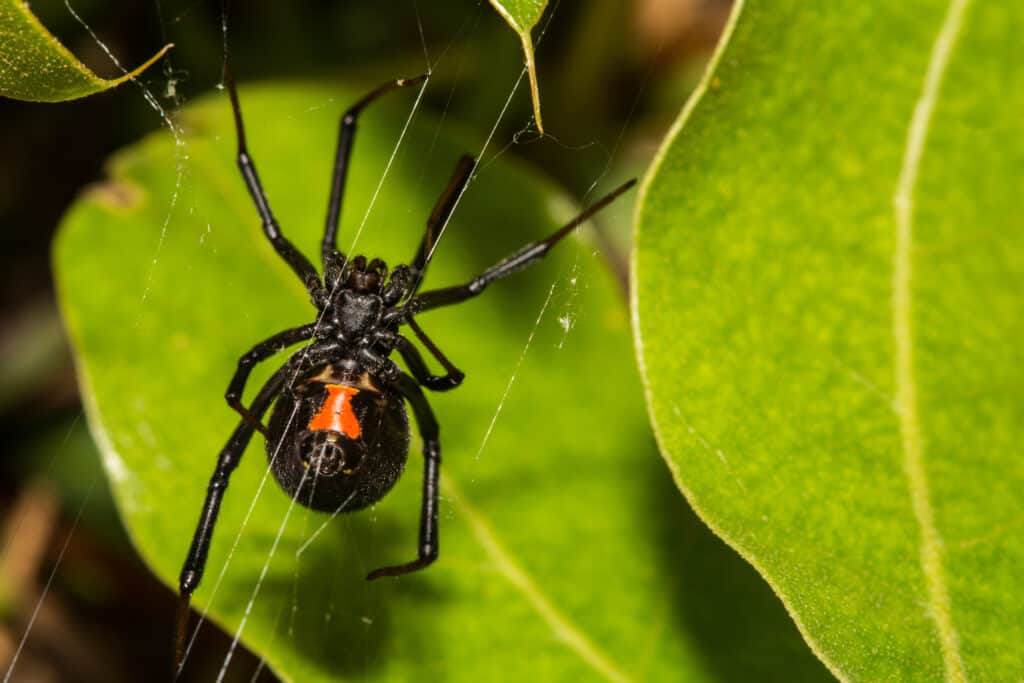
Black Widow spiders are dreaded for their venom. Look for the hourglass — broken or whole — to identify them. They’re some of the most dangerous spiders in Mississippi.
©Jay Ondreicka/Shutterstock.com
The black widow spider is one of the most dangerous spiders in Mississippi. The arachnids build webs in tight, cluttered corners and bear a bright warning: red spots or hourglass markings on their abdomens. If you see one of these, stay away.
Black Widow Identification
Two types of black widow spiders may be found in Mississippi. The northern and southern black widows are mostly the same, save for the hourglasses on their abdomen.
Northern black widows have a broken red or orange hourglass marking on the underside of the abdomen, while the southern has a complete or whole hourglass. Females for either species may have a row of red spots on their bodies or no markings at all. Both males and females bear spiny legs.
Black Widow Habitats
Cluttered areas like attics, garages, back porches, sheds, and storage units make for the perfect home for black widows. They prefer these kinds of spaces for building their webs. Overhanging ledges, outbuildings, under benches, and abandoned rodents burrows also draw them in.
Symptoms of Black Widow Bites
Black widow venom affects the nervous system of humans plaguing victims with a variety of painful symptoms when bitten.
- Fang marks where the bite occurs may be followed with burning, severe pain, redness, and swelling.
- Muscle pains and stiffness may develop within 8 hours, all through the body.
- Excessive sweating may follow in more severe cases.
- Rashes, itching, and swollen eyes may occur.
- Nausea or vomiting may cause dehydration.
- Stomach cramps, severe abdominal pain, and difficulty breathing often appear in more severe cases. If any of these occur, seek medical attention immediately.
Brown Recluse (Loxosceles reclusa)
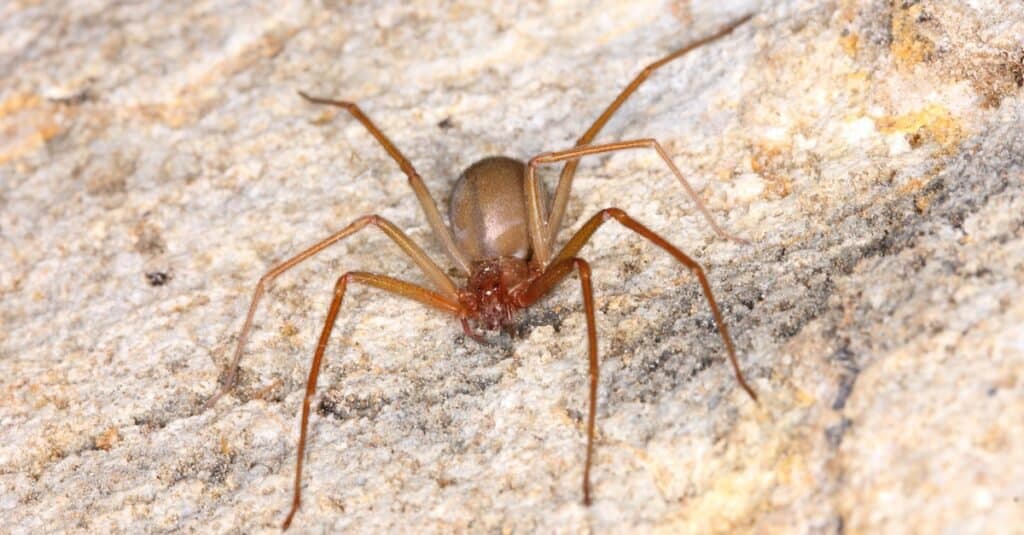
The
brown recluse spider
is one of the most dangerous spiders in the United States. Its venom destroys the walls of blood vessels near the site of the bite, sometimes causing a large skin ulcer. This can lead to necrosis and, in extreme cases, death.
©Pong Wira/Shutterstock.com
If bitten by a brown recluse, you might not even know it in the moment. However, it won’t take long to see the signs of the venomous bite from this dangerous spider in Mississippi.
Brown Recluse Identification
Medium-sized spiders, brown recluses grow between 0.24 and 0.79 inches in length, with longer legs. Occasionally, these spiders grow larger. Coloration tends between light to medium brown, though some are pale off-white, or have dark, almost black-gray or dark brown bodies. Heads/thorax (called a cephalothorax) may vary in color from the rest of the body.
The spider has the nickname of “fiddle” of “violin” spider, as well, due to the violin-shaped markings on its back, in brown lines. Not all brown recluses have these markings, however.
Brown Recluse Habitats
The brown recluse spider lives up to its name in that it prefers to be away from human activity. These hermit-like arachnids often reside within human-made structures, but generally hide away between walls, in dark, undisturbed corners, and in out buildings. They most often appear during refurbishments and when structures are moved or razed. You may also find them in rock and woodpiles. They don’t build webs, either, so recognizing their specific habitat may prove more challenging.
Symptoms of Brown Recluse Bites
The bite of a brown recluse spider rarely results in death, but they remain one of the most dangerous spiders in Mississippi. If you are bitten, you may experience any of the following symptoms.
- Reddened skin around the wound
- Blistering, irritated skin at the wound site
- Swelling and itchiness
- Necrosis of flesh (decaying of flesh)
- Lethargy
- Flu-like symptoms, including fever, body aches, chills, exhaustion
- Flat purple or red spots all over the body
- Body-wide rashes
Victims of brown recluse bites often suffer lingering symptoms and may take as long as 6 to 8 weeks to recover fully. Those with allergies should seek medical attention immediately, as hospitalization may be required.
Brown Widow (Latrodectus geometricus)
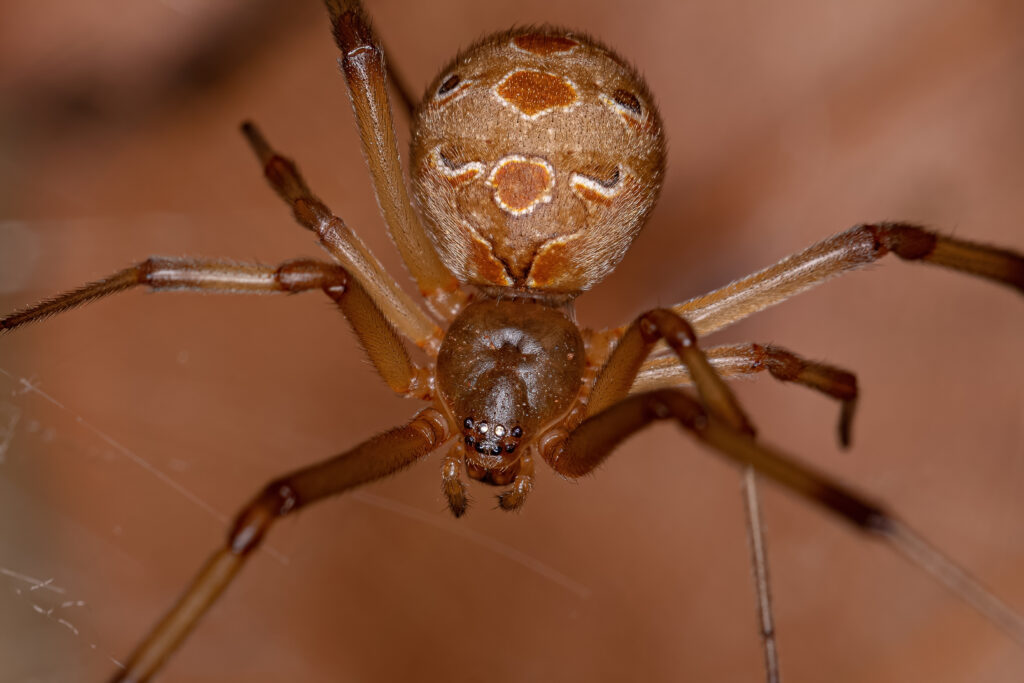
Brown-black widows are sometimes known as brown widows. They’re not quite as scary, but they’re still one of the most dangerous spiders in Mississippi.
©iStock.com/ViniSouza128
Part of the widow family, but lesser known than the one lending its name to a Marvel character, the brown widow packs a dangerous bite. You’ll want to watch out for these arachnids and avoid them at all costs.
Brown Widow Identification
Brown widow spiders, or grey widows, come in a range of light brown to gray-brown shades. Their abdomens sport the famous hourglass shape but in orange instead of red like their cousins. The hourglass rests on the underside of their bodies. Females usually measure between 1/4 and 5/8 inches long, while males usually come in at about half that size. Both sexes have light brown legs and dark joints, and the hourglass may be whole or broken.
Brown Widow Habitats
Non-native to Mississippi, brown widow spiders have become adept in locating safe locations to build their webs. They particularly find buildings and warm areas comfortable, so always check webs on the outside of the house before sweeping them away. They may be tucked into corners of garages, pantries, closets, or anywhere else crowded and warm.
Brown Widow Bites
While still quite toxic, brown widows’ venom is less dangerous than that of the black widow. Additionally, they are shy and rarely bite.
If, by chance, you are bitten by one of the nasty eight-legged beasts, you would notice any of the following symptoms:
- High blood pressure
- Vomiting
- Excessive sweating
- Respiratory muscle weakness
- Seizures
- Stiff abdomen, mimicking appendicitis
The worst of the symptoms generally hit within the first 8 to 12 hours.
Black-Footed Yellow Sac Spider (Cheiracanthium inclusum)
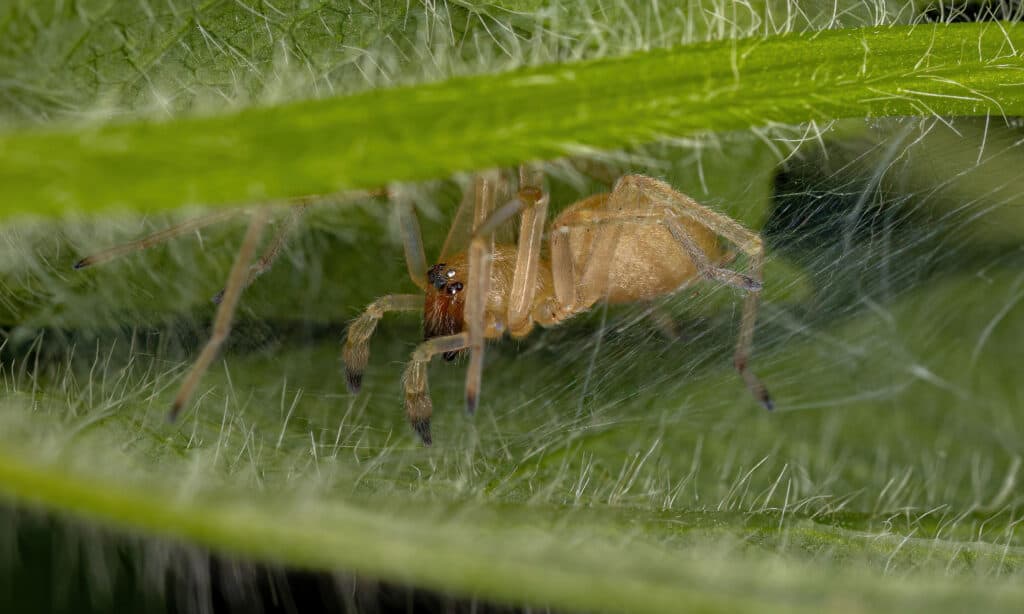
The black-footed
yellow sac spider
builds a silk sac to protect itself from predators during the day. They’re easy to identify by their coloring, particularly those dark feet.
©iStock.com/ViniSouza128
Not as terrifying, nor as deadly as black widows, black-footed yellow sacs spiders still top the list of most dangerous spiders in Mississippi. The tiny little arachnids pack a venomous bite that won’t likely cause permanent damage, but it will still hurt pretty badly and could make you ill.
Black-Footed Yellow Sac Spider Identification
You can identify black-footed yellow sac spiders by their pale, yellow-to-beige coloration. They have dark brown markings on their palps, feet tips (earning their name), and jaws. You may also spot an orange-brown stripe down the center of its back. Overall, their bodies may reach up to 1/4 to 3/8 inch in size, with legs spanning as much as an inch.
Black-Footed Yellow Sac Spider Habitats
These spiders build their webs primarily in tree foliage and shrubs. They also sneak indoors to hunt, and build webs in corners, under appliances, and in closets where insects roam and they won’t be disturbed much. They’ve also been known to inhabit fuel systems and ventilation tubes on vehicles.
Symptoms of Black-Footed Yellow Sac Spider Bites
Thankfully, yellow sac spiders rarely bite. But when they do, symptoms may include intense itching and swelling that lasts up to 10 days. You may wish to invest in a natural spider bite oil to relieve the itching and pain.
The bite is uncomfortable for most, but those who are allergic should seek immediate medical attention. No known cases of necrosis have occurred from yellow sac spider bites.
Runners Up: Wolf Spiders
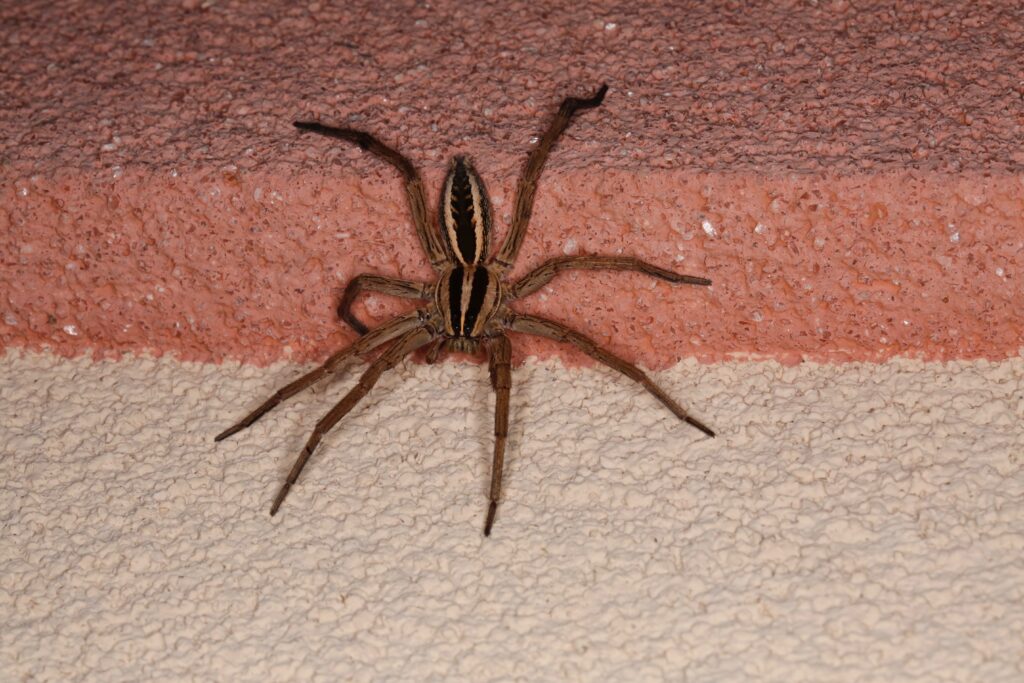
Wolf spiders are brown and furry and grow to a few inches in length. Folks often mistake them for tarantulas. They’re not usually dangerous, but for folks with allergies, they can be problematic. Otherwise, the venom still hurts as it penetrates the skin.
©Cathleen Wake Gorbatenko/Shutterstock.com
While they’re not terribly venomous, wolf spiders may cause issues for folks with allergies. They’re also more likely to bite than many other spider species in Mississippi. Primarily, these bites occur because the arachnid species are so prevalent throughout the state.
If you’re allergic to spiders, wolf spider bites may cause severe symptoms, so seek medical attention immediately. If you are not allergic, the bite of these furry brown spiders may cause itching and pain for a time. Keep an eye on bites and look for any swelling. If significant swelling occurs, seek medical attention immediately, even if you’re not allergic.
What to Do if Bitten By a Venomous Spider
If you or a loved one are bitten by a venomous spider, you should do the following to avoid potential infection or severe risks.
- With gentle soap and water, immediately clean the wound.
- Apply a cold damp cloth or ice pack to the affected area to reduce swelling.
- Elevate the wound, if possible.
- Use over-the-counter painkillers and anti-inflammatory medications to ease symptoms.
- If symptoms worsen, seek medical attention as soon as possible.
The photo featured at the top of this post is © iStock.com/ViniSouza128
Thank you for reading! Have some feedback for us? Contact the AZ Animals editorial team.







